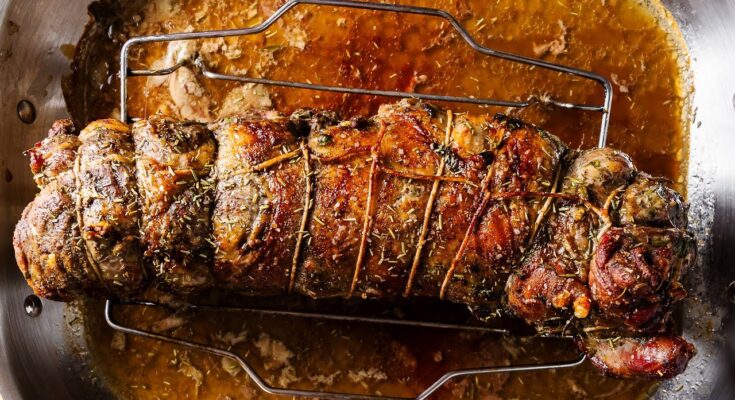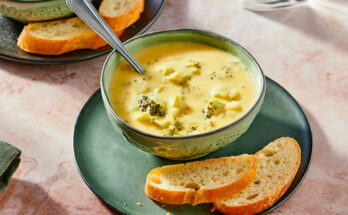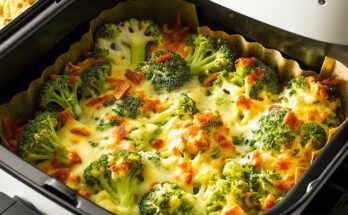Boneless Lamb Leg Recipe: Juicy, flavorful, and packed with rich aroma—there’s nothing quite like a perfectly roasted boneless lamb leg. Whether you’re cooking for a festive dinner or just want to impress your guests with a gourmet dish, this guide will walk you through every detail of preparing the perfect lamb leg from start to finish.
Let’s jump right into it, shall we?
Why Choose a Boneless Lamb Leg?
Boneless lamb leg is a star in the meat world for a good reason. It’s versatile, easy to handle, and when cooked right, it melts in your mouth with incredible tenderness. Unlike bone-in cuts, it cooks more evenly and is much easier to carve—perfect for beginners or seasoned cooks looking for convenience.
With a boneless cut, you also get more control over flavors. You can butterfly it, stuff it, roll it, or simply marinate and roast it. It’s like the blank canvas of the lamb world. Plus, trimming and seasoning are a breeze when you’re not navigating around bones.
Another bonus? It cooks faster. You can save precious oven time while still getting that rich, deep lamb flavor that pairs beautifully with a variety of spices, herbs, and sauces.
Best Cooking Methods for Boneless Lamb Leg
Before diving into the recipe, let’s look at the top ways to cook a boneless lamb leg:
- Roasting: This is the most traditional and flavorful method. A nice sear followed by oven roasting brings out the best in lamb.
- Grilling: Perfect for butterflied boneless legs. High heat, smoky flavor, and a beautiful char.
- Slow cooking: Great for making the lamb fall-apart tender. Works well with bold spices and brothy sides.
- Sous vide: If you’re into precision, sous vide will give you the most consistent results with zero guesswork.
For this guide, we’ll focus on the oven-roasted method because it’s easy, reliable, and gives stunning results every time.
List of Ingredients You’ll Need
Here’s what you’ll need to gather before getting started. These ingredients are for a 3 to 4-pound boneless lamb leg, which serves 6 to 8 people.
Fresh Ingredients:
- 1 boneless lamb leg (3–4 lbs)
- 6 garlic cloves (minced or crushed)
- 2 tablespoons fresh rosemary (chopped)
- 1 tablespoon fresh thyme (chopped)
- Zest and juice of 1 lemon
- 3 tablespoons olive oil
Pantry Essentials:
- 2 teaspoons kosher salt (adjust to taste)
- 1 teaspoon black pepper
- 1 teaspoon paprika
- 1 teaspoon Dijon mustard (optional)
- ½ teaspoon crushed red pepper flakes (optional, for a bit of heat)
Optional Add-Ins:
- 1 tablespoon balsamic vinegar (for extra depth)
- 1 teaspoon ground cumin (if going Mediterranean)
- Chopped fresh mint (for garnish)
With these ingredients, you’ll build a flavor-packed profile that enhances the lamb without overpowering its natural richness.
Kitchen Tools You’ll Need
Before we get messy, make sure you’ve got these tools ready:
- Roasting pan or cast-iron skillet
- Sharp chef’s knife
- Cutting board
- Mixing bowl (for the marinade)
- Kitchen twine (for tying the lamb)
- Meat thermometer (super important)
- Aluminum foil (for resting the meat)
- Basting brush (optional)
Step-by-Step Preparation Guide
Let’s break this down. No stress. Just follow along step by step, and you’ll nail it.
Step 1: Prepping the Boneless Lamb Leg
Remove the lamb from the fridge at least 30–45 minutes before cooking to let it come to room temperature. This ensures even cooking.
If it’s tied with netting, remove it and lay the lamb flat. Trim any excess fat, but don’t remove it all—the fat adds flavor!
Pat the meat dry with paper towels. Moisture is the enemy of a good sear.
Step 2: Making the Marinade
In a bowl, combine:
- Garlic
- Rosemary
- Thyme
- Lemon juice and zest
- Olive oil
- Mustard
- Salt, pepper, and paprika
Mix until it becomes a paste. Smell that? Yep. That’s flavor heaven.
Step 3: Marinating the Lamb
Rub the marinade all over the lamb, pressing it into every nook and cranny.
If you have time, marinate it overnight in the fridge for deeper flavor. If not, let it sit for at least 1 hour before roasting.
Roll up the lamb tightly and tie it with kitchen twine every 2 inches. This helps it cook evenly and look beautiful when sliced.
Step 4: Prepping the Oven
Preheat your oven to 400°F (200°C).
Place a rack in the center of the oven. If using a roasting pan, set the lamb on a rack inside it to allow air circulation and prevent sogginess.
Step 5: Searing (Optional but Recommended)
Want a golden crust? Heat a cast-iron skillet with a little oil and sear the lamb on all sides for about 2–3 minutes per side.
This step builds flavor and gives the outside a beautiful color.
Step 6: Roasting the Boneless Lamb Leg
Transfer the seared lamb to a roasting pan and roast uncovered for:
- 20 minutes per pound for medium-rare (internal temp of 135°F/57°C)
- 25 minutes per pound for medium (140°F/60°C)
Use a meat thermometer! It’s the only way to be sure. Stick it into the thickest part of the lamb without touching any fat or the pan.
Step 7: Checking for Doneness
Here’s a quick temp guide:
| Doneness | Temperature (Remove At) | Final Temp After Resting |
|---|---|---|
| Rare | 120°F (49°C) | 125°F (52°C) |
| Medium Rare | 130°F (54°C) | 135°F (57°C) |
| Medium | 135°F (57°C) | 140°F (60°C) |
| Medium Well | 145°F (63°C) | 150°F (65°C) |
Use this table as your roast timing bible.
Step 8: Resting and Slicing the Meat
Once it hits your desired temp, remove the lamb from the oven, tent it loosely with foil, and let it rest for 15–20 minutes.
Why? Resting lets the juices redistribute, so your lamb isn’t dry when you slice it.
After resting, slice it against the grain into thin pieces. Serve immediately or keep warm under foil until ready to serve.
Flavor Variations and Marinade Ideas
One of the best things about boneless lamb leg? It’s a blank canvas. You can go bold, bright, spicy, or subtle—whatever your taste buds are craving. Here are some tasty flavor profiles you can experiment with:
Mediterranean Style
- Marinade Ingredients: Olive oil, lemon juice, garlic, oregano, rosemary, thyme, and a pinch of cinnamon.
- Perfect With: Roasted potatoes, tzatziki sauce, Greek salad.
- Flavor Profile: Bright, herbaceous, and slightly tangy. Think summer in Santorini.
Garlic and Rosemary
- Marinade Ingredients: Lots of minced garlic, rosemary, olive oil, and cracked black pepper.
- Perfect With: Mashed potatoes, roasted carrots, and gravy.
- Flavor Profile: Classic and comforting. It’s the Sunday roast you dream about all week.
Indian Spiced
- Marinade Ingredients: Yogurt, turmeric, cumin, coriander, garlic, ginger, garam masala, chili powder.
- Perfect With: Basmati rice, naan, cucumber raita.
- Flavor Profile: Warm, spicy, and aromatic. A real showstopper for spice lovers.
Want a shortcut? Use a pre-made spice rub or curry paste mixed with olive oil. Just don’t skip the garlic—lamb and garlic are a match made in culinary heaven.
Best Side Dishes to Serve with Boneless Lamb Leg
The lamb is the star, but what you serve it with can take your meal to the next level. Here are some side dish ideas that pair beautifully with a boneless lamb leg:
Starch-Based Sides
- Garlic Mashed Potatoes: Creamy, fluffy, and rich—perfect for soaking up the lamb juices.
- Herbed Couscous: Light and fluffy with hints of lemon and parsley.
- Roasted Baby Potatoes: Tossed in olive oil, garlic, and rosemary.
Vegetable Sides
- Honey-Glazed Carrots: Slightly sweet to balance the savory lamb.
- Roasted Asparagus or Green Beans: Crisp and bright with a splash of lemon.
- Sauteed Spinach or Kale: Great if you’re keeping it low-carb.
Bread and Extras
- Crusty Artisan Bread: For mopping up all that leftover marinade and meat juice.
- Yorkshire Puddings: Traditional and oh-so-indulgent with a savory lamb roast.
- Tzatziki or Mint Yogurt Sauce: Cool, creamy, and fresh to cut through the richness.
How to Store Leftover Lamb
Cooked lamb stores surprisingly well and makes for some seriously delicious leftovers. Whether you’re saving it for a weekday lunch or freezing it for a future dinner, here’s how to store it properly:
Refrigerating
- How: Slice the lamb and place it in an airtight container.
- Storage Time: Keeps well in the fridge for 3 to 4 days.
- Tip: Add a splash of broth or pan juices before sealing to keep it moist.
Freezing
- How: Wrap individual slices in foil or plastic wrap, then place in a freezer bag.
- Storage Time: Up to 3 months.
- Tip: Label with the date and portion size for easy reheating.
Reheating Tips
- Use a skillet with a little broth or gravy to gently reheat.
- Avoid the microwave if possible—it tends to dry lamb out.
- If microwaving, wrap the lamb in a damp paper towel to retain moisture.
Tips and Tricks for the Perfect Boneless Lamb Leg
Here’s the inside scoop on making sure your lamb is unforgettable every time:
- Let It Rest: This is non-negotiable. Resting keeps it juicy.
- Use a Thermometer: Guesswork ruins meat. Always check temps.
- Don’t Overseason: Lamb is rich and doesn’t need a million spices. Simplicity works.
- Sear for Flavor: A golden crust = deeper flavor.
- Butterfly for Even Cooking: If your roast is uneven in thickness, butterfly it so it cooks uniformly.
Bonus tip? Save those pan drippings! You can make a killer gravy or sauce with them.
Common Mistakes to Avoid
Let’s be honest—lamb can be intimidating. But with a few key reminders, you can steer clear of rookie mistakes:
- Skipping the Rest Time: Cutting into lamb right out of the oven means dry meat and lost juices.
- Forgetting to Season Properly: Underseasoned lamb is a crime. Be generous with herbs and spices.
- Overcooking: This turns your lamb into dry, chewy sadness. Keep an eye on your thermometer.
- Cooking Cold Meat: Let it sit out before cooking, or it won’t cook evenly.
- Ignoring the Grain: Always slice against the grain for tender bites.
Nutritional Value of Boneless Lamb Leg
Boneless lamb leg isn’t just tasty—it’s packed with nutrients. Here’s a quick look at what you’re getting per 100g cooked lamb:
| Nutrient | Amount |
|---|---|
| Calories | 250–270 |
| Protein | 25–28g |
| Fat | 15–18g |
| Saturated Fat | 6–7g |
| Iron | 2.0mg |
| Vitamin B12 | 2.3mcg |
| Zinc | 4.0mg |
It’s an excellent source of protein and essential vitamins, especially B12 and iron—great for energy and immunity.
Lamb Cooking Temperature Guide
Getting the internal temperature right is the most important part of cooking lamb. Here’s a quick cheat sheet:
| Doneness | Internal Temp (After Resting) |
|---|---|
| Rare | 125°F (52°C) |
| Medium Rare | 135°F (57°C) |
| Medium | 140°F (60°C) |
| Medium Well | 150°F (65°C) |
| Well Done | 160°F+ (71°C) |
Pro tip: Always remove lamb about 5°F lower than your target temp—it continues cooking as it rests!
Serving Suggestions
Serving lamb is about balance—rich meat with bright, acidic, or creamy sides:
- Wine Pairing: Try a bold red like Cabernet Sauvignon or Syrah.
- Sauce Ideas: Mint sauce, chimichurri, garlic aioli, or balsamic glaze.
- Leftover Ideas: Lamb gyros, tacos, shepherd’s pie, or sandwiches with tzatziki and arugula.
FAQs about Boneless Lamb Leg Recipe
1. Can I cook boneless lamb leg in a slow cooker?
Absolutely! Just marinate it, sear it for flavor, then cook on low for 6–8 hours. It becomes pull-apart tender and perfect for shredding.
2. What’s the best temperature to roast lamb?
Start high at 400°F for 15 minutes to get a crust, then lower to 350°F and continue roasting based on your preferred doneness.
3. Should I tie the boneless lamb leg before roasting?
Yes, tying it helps the lamb cook evenly and hold its shape. Use kitchen twine and tie every couple of inches.
4. Can I use frozen lamb leg for this recipe?
Yes, but make sure it’s fully thawed in the refrigerator before marinating and cooking to ensure even cooking and proper seasoning.
5. How do I keep lamb juicy after cooking?
Let it rest after roasting, slice against the grain, and don’t overcook it. You can also drizzle a bit of pan juice or olive oil before serving.
Final Thoughts
Making a boneless lamb leg might feel like a gourmet endeavor, but it’s surprisingly approachable with the right prep and a bit of patience. The result? A juicy, flavorful, crowd-pleasing centerpiece that will make your meal feel like a celebration. From a cozy Sunday dinner to a special holiday feast, this dish delivers every single time.
Don’t be afraid to experiment, play with flavors, and make it your own. After all, cooking is just as much about joy as it is about precision.


